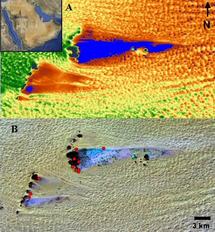
Satellite images have revealed that a network of ancient rivers once coursed their way through the sand of the Arabian Desert, leading scientists to believe that the region experienced wetter periods in the past.
The images are the starting point for a major potentially ground-breaking research project led by the University of Oxford into human evolutionary heritage. The research team will look at how long-term climate change affected early humans and animals who settled or passed through and what responses determined whether they were able to survive or died out.
Until now this part of the world has been largely ignored by scholars despite its critical location as a bridge between Africa and Eurasia. In a project funded by €2.34 million from the ERC (European Research Council), a multidisciplinary team of researchers will study the effects of environmental change in the Arabian Peninsula over the last two million years. The systematic study of the Pleistocene to Holocene periods will be unique in its length and level of detail.
Over the course of five years the researchers will study the landscape features and excavate sites of likely archaeological interest, using the network of water courses as a map. They will use the latest dating techniques to pinpoint the ages of fossils of animals, plants and different stone tool technologies and compare the similarities and differences displayed in the region’s rock art.
From NASA images taken of the Arabian Desert we can see physical landscape features that are visible from space that denote a whole network of former river valleys and lake basins
The team’s main focus will be the Arabian Desert, but the work will also cover the wider Peninsula. One key question they will attempt to answer is when the first early modern humans are likely to have first arrived in the Arabian Peninsula from Africa and perhaps surrounding regions. They will also look for evidence that suggests how early modern humans were able to survive, or not, in arid and extreme conditions.
Project leader Professor Michael Petraglia, Co-Director of the Centre for Asian Archaeology at Oxford University’s School of Archaeology, said: ‘From NASA images taken of the Arabian Desert we can see physical landscape features that are visible from space that denote a whole network of former river valleys and lake basins. These lines and dips in the sand provide us with a map of the region upon which we will focus our research activity. The presence of water is an accurate indicator of where early humans and animals migrated to or settled.
‘The Arabian Peninsula has a wealth of archaeological sites and spectacular deposits of former rivers and lakes. Yet despite its significance as a bridge between two continents, surprisingly very little is known about its early prehistory. This project draws on many disciplines: the sum of which should reveal a hitherto untold but very important story about the effect of climate change on early humans.’
The researchers will identify key excavation sites, including sites where work has already been done, and where stone tools and the fossils of animals, such as wild cattle, have been found. The researchers will also conduct field studies in former lake basins, where fossils of fish of up to a metre long were discovered.
A variety of dating techniques will be used by the researchers to pinpoint the ages of fossils and stone tools to set out the chronologies of archaeological sites. Dating work on animal and faunal fossils could provide new information about possible food sources of early humans, as well as the timing of environmental changes.
The project will examine marine cores, caves, existing wide water wells and quarry pits to view the stratigraphy. They will also examine deposits between 30 to 60 metres deep to measure the effects of environmental change, observing any changes from plant fossils and rocks and strata indicating when the climate was wetter or drier.
The scientists will extract the DNA of animals derived from the Arabian Peninsula. The DNA acts as a molecular clock which can tell the researchers more about that animal’s most recent common ancestor and when it is likely to have arrived. They will examine the DNA of a number of species from museum collections, such as ostrich, oryx, ibex, hyena, and honey badger to establish their origin, their demographic histories, and likely dispersal patterns.














Add Comment